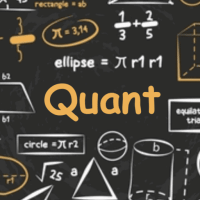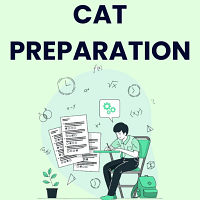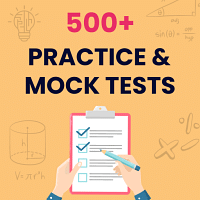CAT Exam > CAT Questions > Directions: In this question, a statement is ...
Start Learning for Free
Directions: In this question, a statement is followed by two conclusions numbered I and II. Assuming everything in the statement to be true, consider the two conclusions and decide which of them follow(s) beyond a reasonable doubt from the information given in the statement.
Mark your answer as
(A) if only conclusion I follows
(B) if only conclusion II follows
(C) if either conclusion I or conclusion II follows
(D) if neither conclusion I nor conclusion II follows
(A) if only conclusion I follows
(B) if only conclusion II follows
(C) if either conclusion I or conclusion II follows
(D) if neither conclusion I nor conclusion II follows
Statement: Objective type questions do not really test a student's clarity of concepts in an examination.
Conclusions:
I. Students usually cram the answers to the objective questions from helping guides.
II. Subjective questions are as much open to doubt to test the same criterion.
Conclusions:
I. Students usually cram the answers to the objective questions from helping guides.
II. Subjective questions are as much open to doubt to test the same criterion.
- a)(A)
- b)(B)
- c)(C)
- d)(D)
Correct answer is option 'D'. Can you explain this answer?
| FREE This question is part of | Download PDF Attempt this Test |

|
Explore Courses for CAT exam
|

|
Directions: In this question, a statement is followed by two conclusions numbered I and II. Assuming everything in the statement to be true, consider the two conclusions and decide which of them follow(s) beyond a reasonable doubt from the information given in the statement.Mark your answer as(A) if only conclusion I follows(B) if only conclusion II follows(C) if either conclusion I or conclusion II follows(D) if neither conclusion I nor conclusion II followsStatement: Objective type questions do not really test a students clarity of concepts in an examination.Conclusions:I. Students usually cram the answers to the objective questions from helping guides.II. Subjective questions are as much open to doubt to test the same criterion.a)(A)b)(B)c)(C)d)(D)Correct answer is option 'D'. Can you explain this answer?
Question Description
Directions: In this question, a statement is followed by two conclusions numbered I and II. Assuming everything in the statement to be true, consider the two conclusions and decide which of them follow(s) beyond a reasonable doubt from the information given in the statement.Mark your answer as(A) if only conclusion I follows(B) if only conclusion II follows(C) if either conclusion I or conclusion II follows(D) if neither conclusion I nor conclusion II followsStatement: Objective type questions do not really test a students clarity of concepts in an examination.Conclusions:I. Students usually cram the answers to the objective questions from helping guides.II. Subjective questions are as much open to doubt to test the same criterion.a)(A)b)(B)c)(C)d)(D)Correct answer is option 'D'. Can you explain this answer? for CAT 2024 is part of CAT preparation. The Question and answers have been prepared according to the CAT exam syllabus. Information about Directions: In this question, a statement is followed by two conclusions numbered I and II. Assuming everything in the statement to be true, consider the two conclusions and decide which of them follow(s) beyond a reasonable doubt from the information given in the statement.Mark your answer as(A) if only conclusion I follows(B) if only conclusion II follows(C) if either conclusion I or conclusion II follows(D) if neither conclusion I nor conclusion II followsStatement: Objective type questions do not really test a students clarity of concepts in an examination.Conclusions:I. Students usually cram the answers to the objective questions from helping guides.II. Subjective questions are as much open to doubt to test the same criterion.a)(A)b)(B)c)(C)d)(D)Correct answer is option 'D'. Can you explain this answer? covers all topics & solutions for CAT 2024 Exam. Find important definitions, questions, meanings, examples, exercises and tests below for Directions: In this question, a statement is followed by two conclusions numbered I and II. Assuming everything in the statement to be true, consider the two conclusions and decide which of them follow(s) beyond a reasonable doubt from the information given in the statement.Mark your answer as(A) if only conclusion I follows(B) if only conclusion II follows(C) if either conclusion I or conclusion II follows(D) if neither conclusion I nor conclusion II followsStatement: Objective type questions do not really test a students clarity of concepts in an examination.Conclusions:I. Students usually cram the answers to the objective questions from helping guides.II. Subjective questions are as much open to doubt to test the same criterion.a)(A)b)(B)c)(C)d)(D)Correct answer is option 'D'. Can you explain this answer?.
Directions: In this question, a statement is followed by two conclusions numbered I and II. Assuming everything in the statement to be true, consider the two conclusions and decide which of them follow(s) beyond a reasonable doubt from the information given in the statement.Mark your answer as(A) if only conclusion I follows(B) if only conclusion II follows(C) if either conclusion I or conclusion II follows(D) if neither conclusion I nor conclusion II followsStatement: Objective type questions do not really test a students clarity of concepts in an examination.Conclusions:I. Students usually cram the answers to the objective questions from helping guides.II. Subjective questions are as much open to doubt to test the same criterion.a)(A)b)(B)c)(C)d)(D)Correct answer is option 'D'. Can you explain this answer? for CAT 2024 is part of CAT preparation. The Question and answers have been prepared according to the CAT exam syllabus. Information about Directions: In this question, a statement is followed by two conclusions numbered I and II. Assuming everything in the statement to be true, consider the two conclusions and decide which of them follow(s) beyond a reasonable doubt from the information given in the statement.Mark your answer as(A) if only conclusion I follows(B) if only conclusion II follows(C) if either conclusion I or conclusion II follows(D) if neither conclusion I nor conclusion II followsStatement: Objective type questions do not really test a students clarity of concepts in an examination.Conclusions:I. Students usually cram the answers to the objective questions from helping guides.II. Subjective questions are as much open to doubt to test the same criterion.a)(A)b)(B)c)(C)d)(D)Correct answer is option 'D'. Can you explain this answer? covers all topics & solutions for CAT 2024 Exam. Find important definitions, questions, meanings, examples, exercises and tests below for Directions: In this question, a statement is followed by two conclusions numbered I and II. Assuming everything in the statement to be true, consider the two conclusions and decide which of them follow(s) beyond a reasonable doubt from the information given in the statement.Mark your answer as(A) if only conclusion I follows(B) if only conclusion II follows(C) if either conclusion I or conclusion II follows(D) if neither conclusion I nor conclusion II followsStatement: Objective type questions do not really test a students clarity of concepts in an examination.Conclusions:I. Students usually cram the answers to the objective questions from helping guides.II. Subjective questions are as much open to doubt to test the same criterion.a)(A)b)(B)c)(C)d)(D)Correct answer is option 'D'. Can you explain this answer?.
Solutions for Directions: In this question, a statement is followed by two conclusions numbered I and II. Assuming everything in the statement to be true, consider the two conclusions and decide which of them follow(s) beyond a reasonable doubt from the information given in the statement.Mark your answer as(A) if only conclusion I follows(B) if only conclusion II follows(C) if either conclusion I or conclusion II follows(D) if neither conclusion I nor conclusion II followsStatement: Objective type questions do not really test a students clarity of concepts in an examination.Conclusions:I. Students usually cram the answers to the objective questions from helping guides.II. Subjective questions are as much open to doubt to test the same criterion.a)(A)b)(B)c)(C)d)(D)Correct answer is option 'D'. Can you explain this answer? in English & in Hindi are available as part of our courses for CAT.
Download more important topics, notes, lectures and mock test series for CAT Exam by signing up for free.
Here you can find the meaning of Directions: In this question, a statement is followed by two conclusions numbered I and II. Assuming everything in the statement to be true, consider the two conclusions and decide which of them follow(s) beyond a reasonable doubt from the information given in the statement.Mark your answer as(A) if only conclusion I follows(B) if only conclusion II follows(C) if either conclusion I or conclusion II follows(D) if neither conclusion I nor conclusion II followsStatement: Objective type questions do not really test a students clarity of concepts in an examination.Conclusions:I. Students usually cram the answers to the objective questions from helping guides.II. Subjective questions are as much open to doubt to test the same criterion.a)(A)b)(B)c)(C)d)(D)Correct answer is option 'D'. Can you explain this answer? defined & explained in the simplest way possible. Besides giving the explanation of
Directions: In this question, a statement is followed by two conclusions numbered I and II. Assuming everything in the statement to be true, consider the two conclusions and decide which of them follow(s) beyond a reasonable doubt from the information given in the statement.Mark your answer as(A) if only conclusion I follows(B) if only conclusion II follows(C) if either conclusion I or conclusion II follows(D) if neither conclusion I nor conclusion II followsStatement: Objective type questions do not really test a students clarity of concepts in an examination.Conclusions:I. Students usually cram the answers to the objective questions from helping guides.II. Subjective questions are as much open to doubt to test the same criterion.a)(A)b)(B)c)(C)d)(D)Correct answer is option 'D'. Can you explain this answer?, a detailed solution for Directions: In this question, a statement is followed by two conclusions numbered I and II. Assuming everything in the statement to be true, consider the two conclusions and decide which of them follow(s) beyond a reasonable doubt from the information given in the statement.Mark your answer as(A) if only conclusion I follows(B) if only conclusion II follows(C) if either conclusion I or conclusion II follows(D) if neither conclusion I nor conclusion II followsStatement: Objective type questions do not really test a students clarity of concepts in an examination.Conclusions:I. Students usually cram the answers to the objective questions from helping guides.II. Subjective questions are as much open to doubt to test the same criterion.a)(A)b)(B)c)(C)d)(D)Correct answer is option 'D'. Can you explain this answer? has been provided alongside types of Directions: In this question, a statement is followed by two conclusions numbered I and II. Assuming everything in the statement to be true, consider the two conclusions and decide which of them follow(s) beyond a reasonable doubt from the information given in the statement.Mark your answer as(A) if only conclusion I follows(B) if only conclusion II follows(C) if either conclusion I or conclusion II follows(D) if neither conclusion I nor conclusion II followsStatement: Objective type questions do not really test a students clarity of concepts in an examination.Conclusions:I. Students usually cram the answers to the objective questions from helping guides.II. Subjective questions are as much open to doubt to test the same criterion.a)(A)b)(B)c)(C)d)(D)Correct answer is option 'D'. Can you explain this answer? theory, EduRev gives you an
ample number of questions to practice Directions: In this question, a statement is followed by two conclusions numbered I and II. Assuming everything in the statement to be true, consider the two conclusions and decide which of them follow(s) beyond a reasonable doubt from the information given in the statement.Mark your answer as(A) if only conclusion I follows(B) if only conclusion II follows(C) if either conclusion I or conclusion II follows(D) if neither conclusion I nor conclusion II followsStatement: Objective type questions do not really test a students clarity of concepts in an examination.Conclusions:I. Students usually cram the answers to the objective questions from helping guides.II. Subjective questions are as much open to doubt to test the same criterion.a)(A)b)(B)c)(C)d)(D)Correct answer is option 'D'. Can you explain this answer? tests, examples and also practice CAT tests.

|
Explore Courses for CAT exam
|

|
Suggested Free Tests
Signup for Free!
Signup to see your scores go up within 7 days! Learn & Practice with 1000+ FREE Notes, Videos & Tests.





















